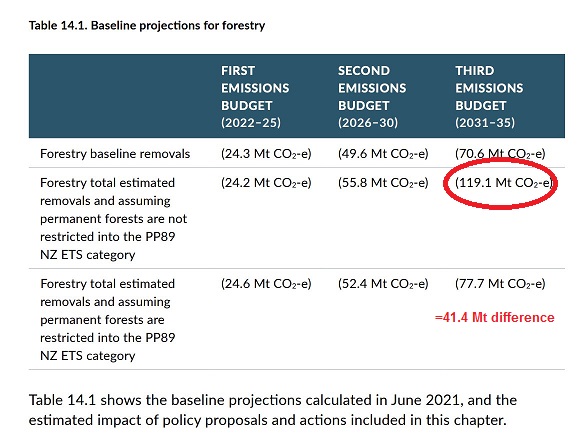The government released its Emissions Reduction Plan today. The plan is required under the Zero Carbon Act and must specify how exactly the government plans to meet its carbon budget (which was announced last week). Which means they need to find another 11.5 million tons of reductions by 2025 - which is a big ask. The plan they've presented might get us there, if things go well, but its going to be dicey. Which suggests that its not strong enough, and they need to do more. The good news, however, is that it looks like some sectors are well on track to exceed their targets for later periods. So if you use the usual metaphor of "turning a supertanker around", the plan seems to turn it for transport and energy.
The big exception here is forestry. Unlike the other sectors, it doesn't have a graph showing "emissions with policy" comfortably below the sector sub-target. And that's because they're not. Forestry under the government's proposals fails to meet its targets in every budget. Which is weird, because we're constantly being told that we're planting too many trees and in danger of soaking up too much carbon. But when the government puts down some hard numbers, it turns out we're not, and that the sector we were relying on to save us, won't. Whoops. Note the "under the government's proposals" there, because one of the government's key proposals is to ban permanent exotic forests from the ETS. The government has helpfully shown us the impact of this policy on a table, and its a doozy:
Yes, that's a 41.4 million ton impact in BP3, or about 17% of the total budget. That's carbon we would be soaking up, but the government has chosen to change the rules to stop it from happening, as a sop to farmers who fear being outcompeted by a more profitable industry. And that carbon has a price: $6 billion using the government's internal carbon price of $150 / ton (which, being based on the Climate Commissions' price estimate for 2030, will be underestimating by a billion or two). This is, in short, a very expensive policy decision, made for very poor reasons, which needs to be reversed. If the government is really worried about too many trees and not enough gross emissions reductions, it can always screw the budgets down tighter to eat the surplus, or even just buy the excess itself and use it to offset its past oversupply of ETS units via the cost-containment reserve and fixed-price option (thus removing the units from the system and preventing them from enabling more emissions).
The other big problem with the plan is agriculture. While there is more to be done, the transport and energy sectors - urban Aotearoa - are pulling their weight. And we're paying for it via the ETS. And the government's proposal is basicly to take a huge chunk of that ETS money and use it to subsidise more predatory delay, in the form of yet another agricultural research center to look for a "magic bullet" to reduce emissions (don't we already have one of these?). But we don't need a magic bullet - real ones (or rather, lower rates of replacement) will do the trick. But the necessary policy of capping and cutting cow numbers is apparently anathema to this government, and so this part of the plan relies on magic technology which does not exist yet to achieve reductions. Which sounds more like crossed fingers and hope than an actual plan. (And it sucks more because, as the plan reminds us, agriculture contributes only 10% to GDP, while being responsible for 50% of emissions. So its the dirty, polluting, unproductive bit which we need to get rid of then).
Finally, there is a lot of cruft and padding. Besides the obvious strategy-speak (which is helping set a framework for future reductions), there's a lot of policies which seem not to have much to do with reducing emissions at all, like paying bus drivers more, or installing rural broadband so farmers can watch porn. Because it turns out that if you run under austerity, but tell agencies that there's a special pot of money they can get things funded with if they can pretend that it reduces emissions, then suddenly those policies become "emissions reduction" policies, purely to meet budget rules.
There's a lot more to pick apart here (the missed opportunities in energy, for a start). But the forestry and agriculture subsections show that the government isn't really serious about those sectors, and therefore not serious about meeting our targets. Which is hardly the "nuclear-free moment" we were promised. But I guess that's what you get from a craven, status quo party: craven, status quo policy.




